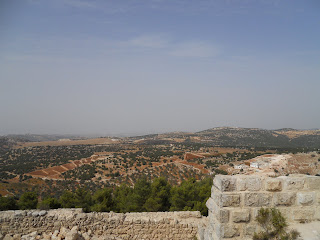
Jerash in northern Jordan is a solemn Roman city spread out over the area of Pompeii. It is remarkably well preserved, and as the tour groups dissipate you get the opportunity to be engulfed in imperial splendor from ages past. Kitschy dramatizations in the hippodrome available for 12 Jordanian dinar.
Atop Aljun castle one can see the Golan Heights (far left, edge of visibility) and Syria (far right, edge of visibility). Aljun was constructed by a nephew of Saladin in the twelfth century to ward off Crusaders. It was subsequently expanded upon and integrated into Mamluk defensive network in later years.
For sale outside the castle is cardamom-infused Arabic coffee freshly brewed over a wood fire.

Typical avenue in northern Jordan.

Amman Beach at the Dead Sea offers visitors a chance to unwind by floating comically in the high-salinity, oily, mineral-enriched water. Across the seascape one can faintly discern structures on the West Bank.

The King Husseini Mosque is one of downtown Amman's chief attractions. This impromptu bus station here on King Faisal street gives commuters access to the city's chief arteries.

The ancient Nabatean merchant city of Petra -- later occupied and expanded by the Romans -- contains more than 70 tombs carved into cliffs, a massive temple, a memorial to the Roman governor of Arabia from Hadrian's era, a colonnaded mercantile avenue and an amphitheater. Even though it is saturated with tourists and overly aggressive Bedouin tour guides, the city is so massive and sprawling that a visitor will find himself or herself alone in solemnity more than once.

Typical avenue in northern Jordan.

Amman Beach at the Dead Sea offers visitors a chance to unwind by floating comically in the high-salinity, oily, mineral-enriched water. Across the seascape one can faintly discern structures on the West Bank.
Amman by night takes on a surprisingly romantic appearance.

The King Husseini Mosque is one of downtown Amman's chief attractions. This impromptu bus station here on King Faisal street gives commuters access to the city's chief arteries.

The ancient Nabatean merchant city of Petra -- later occupied and expanded by the Romans -- contains more than 70 tombs carved into cliffs, a massive temple, a memorial to the Roman governor of Arabia from Hadrian's era, a colonnaded mercantile avenue and an amphitheater. Even though it is saturated with tourists and overly aggressive Bedouin tour guides, the city is so massive and sprawling that a visitor will find himself or herself alone in solemnity more than once.


















